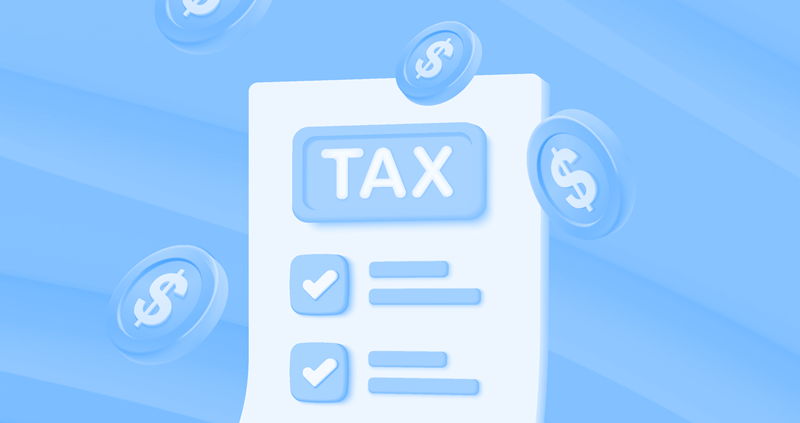What is a marginal tax rate? A simple guide for taxpayers
Learn how marginal tax rates work, why they matter for your take-home pay, and how to calculate your marginal tax rate.
What are marginal tax rates: Your marginal tax rate is the rate you pay on your last dollar earned and the tax bracket you fall into for your highest income.
Do marginal tax rates affect your entire paycheck: Marginal tax rates apply only to the income within a specific bracket, not your entire earnings.
Understanding your marginal tax rate: Understanding your marginal rate helps you better plan, budget, and avoid misconceptions about how much tax you really owe.
Understanding the marginal tax rate
Ever wondered why your paycheck doesn't shrink at the same rate as your salary grows? Marginal tax rates and the U.S. progressive tax system make calculating your tax bill a bit different from what it might seem at first.
Your marginal tax rate is the highest rate you will pay on your taxable income and is based on the federal income tax bracket you're in. Understanding what the marginal tax rate is, how the rates work, and what tax bracket you’re in is important because your income is not taxed all at the same rate. This can allow you to have a clearer overview of your take-home pay, which can help you budget and save more efficiently.
Let’s take a closer look at marginal tax rates and how the U.S. progressive tax system works.
Definition of marginal tax rate
The marginal tax rate is the percentage you pay on your last dollar of income.
Different portions of your income are taxed at different rates. So the marginal tax rate applies only to income within a specific tax bracket, meaning higher earnings may be taxed at higher rates progressively.
How the U.S. tax system works
The U.S. follows a progressive tax system, meaning that the more income you earn, the more incremental tax you will pay. Your income is divided into brackets, with each portion taxed at its corresponding rate. So the first portion of your income is taxed at the lowest rate, the next portion at a higher rate, and so on until your last dollar.
Marginal tax rates essentially determine how much you pay on the highest dollar you earn, and not the average you pay across all of your income. This is also the reason why people with higher earnings end up in higher brackets, but still benefit from lower rates on their initial income.
Understanding your marginal tax rate and how your income is taxed is important, as it is a common misunderstanding that all of your income is taxed at the same rate. To get a better overview of how these progressive tax rates work, let’s look at the tax rates for 2025.
Marginal tax brackets: 2025 snapshot
Here are the adjusted marginal rates for tax year 2025, which will apply to tax returns to be filed starting in tax season 2026:1
Rate | Single filers | Married couples filing jointly | Head of household |
10% | $0 to $11,925 | $0 to $23,850 | $0 to $17,000 |
12% | $11,926 to $48,475 | $23,851 to $96,950 | $17,001 to $64,850 |
22% | $48,476 to $103,350 | $96,951 to $206,700 | $64,851 to $103,350 |
24% | $103,351 to $197,300 | $206,701 to $394,600 | $103,351 to $197,300 |
32% | $197,301 to $250,525 | $394,601 to $501,050 | $197,301 to $250,500 |
35% | $250,526 to $626,350 | $501,051 to $751,600 | $250,501 to $626,350 |
37% | $626,350+ | $751,600+ | $626,351+ |
It is important to note that tax rates may be adjusted annually, meaning income thresholds may fluctuate. Checking the IRS website can help ensure you have the most up-to-date information.
Real-life examples: How marginal tax rates work
To get a better understanding of how marginal tax rates work in practice, let’s look at two hypothetical examples of calculations based on the 2025 tax brackets:
Case study: Single filer
Imagine you are a single filer and had a gross income of $95,000 in 2025 and a taxable income of $80,000 after standard deductions. To calculate your marginal tax rates, you will need to take the percentage from the progressive scale listed above from dollars earned within each bracket.
Considering your $80,000 taxable income, your marginal tax rates would equate to:
Tax rate | Taxable income for single filers | Taxes owed per marginal tax bracket (bracket's taxable income × bracket's tax rate) |
10% | $0 to $11,925 | $11,925 × 10% = $1,192.50 |
12% | $11,926 to $48,475 | ($48,475 - $11,925) × 12% = $4,386 |
22% | $48,476 to $103,350 | ($80,000 - $48,475) × 22% = $6,935.50 |
Total taxes owed: $12,514
In this case, even though you fell into the 22% tax bracket as a single filer, you did not owe a flat tax rate of 22% across your entire taxable income due to the progressive tax rate system in the U.S., which would have been $17,600 total taxes owed.
Case Study: Married filing jointly
Let’s consider another hypothetical scenario where you are married filing jointly with a gross income of $140,000 in 2025 and a taxable income of $110,000 after standard deductions.
Your marginal tax rate breakdown would look something like this:
Tax rate | Taxable income for those married filing jointly | Taxes owed per marginal tax bracket (bracket's taxable income × bracket's tax rate) |
10% | $0 to $23,850 | $23,850 × 10% = $2,385 |
12% | $23,851 to $96,950 | ($96,950 - $23,850) × 12% = $8,772 |
22% | $96,951 to $206,700 | ($110,000 - $96,950) x 22% = $2,871 |
Total taxes owed: $14,028
In this case, even though you had a higher income, you still did not owe a flat rate across your total taxable income, due to the marginal tax rates.
What is my marginal tax rate?
After taking a look at some examples, you might have a better overview on how to calculate marginal tax rates. To calculate your individual marginal tax rates, you will need to know your relevant filing status (e.g., single or head of household) and your total taxable income.
Your total taxable income can be calculated by:
Adding all your sources of income to determine your gross income.
Subtracting standard deductions, or above-the-line deductions (e.g., contributions to a traditional IRA, student loan interest, HSA contributions, etc.) to determine your adjusted gross income (AGI).
Decide if you will claim standard (determined by the IRS) or itemized deductions (deducting eligible costs like medical expenses, charitable contributions, mortgage interest, etc.).
Subtract your standard or itemized deduction from your AGI to determine your taxable income.
You could also use tools from the IRS, like their tax withholding estimator, to help you get an estimate on how much taxes you will owe.
It’s also important to remember that marginal tax rates only apply to the last dollar you earn. If you want to know the full rate of what you’re actually paying in taxes, you’ll need to calculate your effective tax rate — the percentage of your total income owed to the IRS. If you want to learn more about effective tax rates, you can turn to our page explaining the difference between effective and marginal tax rates.
Common misconceptions about marginal tax rates
Learning about marginal tax rates not only helps you better understand how you will get taxed, but also helps you avoid common misconceptions about taxes. Misunderstandings can cause you to overestimate your tax burden or make financial decisions based on inaccurate assumptions.
Here are some common misconceptions about marginal tax rates:
Myth: If I move into a higher tax bracket, all my income is taxed at that higher rate.
False. Only the portion of income above the bracket threshold is taxed at the higher rate. The rest is still taxed at the lower rates.
Myth: My marginal tax rate is the same as my overall (effective) tax rate.
Not true. Your marginal rate is the rate on your last dollar earned, while your effective rate is your total tax divided by total income (usually much lower).
Myth: Bonuses are taxed more than regular salary.
- Employers may withhold at a higher flat rate for simplicity, but at tax time, bonuses are taxed as ordinary income just like wages.
Bottom line: Building confidence in your financial future
Understanding how marginal tax rates work can remove much of the confusion — and anxiety — around your tax bill. Knowing that moving into a higher bracket only affects the next dollar you earn (and not your entire income) can help you better plan for raises, bonuses, or career changes with confidence. By learning how taxable income is calculated and recognizing the difference between marginal tax brackets, you’ll have a clearer picture of your real tax burden. Using this knowledge can help you make smarter decisions about saving, budgeting, investing, and building long-term financial security.
If you want to boost your savings, Raisin is here to help. The Raisin marketplace gives you access to a variety of high-yield savings products with competitive interest rates to help you make the most of your money. Explore account types, compare interest rates, and sign up today to start maximizing your savings potential!
FAQs on marginal tax rates
Does my marginal tax rate apply to all my income?
No. Your marginal tax rate only applies to the portion of income that falls within your highest bracket. Lower portions of your income are taxed at lower rates.
How does a raise affect my marginal tax rate?
A raise could push some of your income into a higher bracket, but only the income above that bracket threshold is taxed at the higher rate. The rest remains taxed at lower rates.
Can deductions lower my marginal tax rate?
Yes. Deductions reduce your taxable income, which can lower the amount of income that falls into higher brackets, potentially reducing your marginal tax rate.
What happens if I move into a higher tax bracket?
Only the portion of income that exceeds the threshold of the new bracket is taxed at the higher rate. Your entire income will not be taxed at that higher rate.
The above article is intended to provide generalized financial information designed to educate a broad segment of the public; it does not give personalized tax, investment, legal, or other business and professional advice. Before taking any action, you should always seek the assistance of a professional who knows your particular situation for advice on taxes, your investments, the law, or any other business and professional matters that affect you and/or your business.


